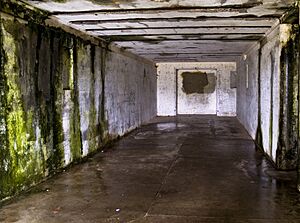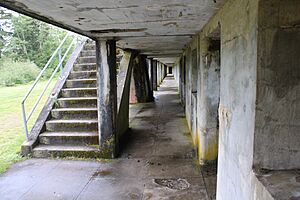Fort Stevens (Oregon) facts for kids
Quick facts for kids Fort Stevens |
|
|---|---|
| Warrenton, Clatsop County, Oregon | |
 |
|
| Type | Military base |
| Site information | |
| Controlled by | United States Army |
| Condition | Preserved |
| Site history | |
| Built | 1863 |
| In use | 1863–1947 |
| Materials | Concrete, steel |
| Battles/wars | Bombardment of Fort Stevens |
| Events | |
|
Fort Stevens
|
|
| Lua error in Module:Location_map at line 420: attempt to index field 'wikibase' (a nil value). | |
| Location | Fort Stevens State Park, Hammond, Oregon |
| Area | 542 acres (219 ha) |
| Built | 1863 |
| NRHP reference No. | 71000678 |
| Added to NRHP | September 22, 1971 |
Fort Stevens was an important American military base in Oregon. It was built to guard the mouth of the Columbia River. The fort was named after Isaac I. Stevens, a Civil War general and former governor of Washington Territory.
Fort Stevens was an active military site from 1863 until 1947. Today, it is a special place listed on the National Register of Historic Places. You can visit it as an Oregon state park near Warrenton.
Contents
Fort Stevens: A Historic Oregon Fort
Building a Fort for Protection
Fort Stevens was first built between 1863 and 1864. It was created during the American Civil War as a dirt fort, called an "earthwork battery." This early fort was on the south side of the Columbia River's entrance. It was first known as the Fort at Point Adams.
In 1865, the fort was renamed Fort Stevens. This honored Isaac Stevens, who had been killed in battle during the Civil War. Fort Stevens was the main part of a defense system for the Columbia River. This system included two other forts, Fort Canby and Fort Columbia, on the Washington side of the river. The fort's job was to protect the river from possible attacks. It was especially important during times of tension with Great Britain, like the Pig War and the Alaska Boundary Dispute.
Shipwreck Story: The Peter Iredale
In 1906, a famous event happened near Fort Stevens. A sailing ship called the Peter Iredale got stuck on the sand. Its crew found safety at Fort Stevens. You can still see the remains of this shipwreck today within Fort Stevens State Park. It's a popular spot for visitors!
Fort Stevens in World War II
After World War I, the U.S. Navy set up a radio station at Fort Stevens. This station helped communicate with naval ships. In 1932, a secret radio station was also placed there. Its job was to listen to and understand coded messages from the Japanese navy. Special radio operators, known as the "On-the-Roof-Gang," worked at this listening post.
Under Attack!
Fort Stevens made history during World War II. On the night of June 21–22, 1942, a Japanese submarine called the I-25 appeared off the coast. It fired 17 shells from its large deck gun. This made Fort Stevens the first military base in the Contiguous United States to be attacked by an enemy during World War II.
Luckily, the attack did not damage the fort itself. The shells only hit the backstop of the fort's baseball field. Soldiers from the 249th Coast Artillery and the 18th Coast Artillery were stationed at Fort Stevens during the war.
After the War: A Park is Born
Fort Stevens was officially closed down in 1947. All its weapons were removed, and its buildings were sold. The land was first given to the United States Army Corps of Engineers. Then, in 1975, it became part of the Oregon Parks and Recreation Department.
Explore Fort Stevens State Park Today
Today, much of the old Fort Stevens is preserved within Fort Stevens State Park. This park is also part of the Lewis and Clark National Historical Park. It covers about 3,700 acres (15 km2) and offers many fun activities.
You can go camping, enjoy the beach, or swim at Coffenbury Lake. There are also trails for hiking and biking, and a museum about the fort's military history. Fort Stevens State Park is very popular, with over a million visitors each year. The park has many campsites, including ones for RVs and cabins. There are more than nine miles of paved bike trails, great fishing spots, and the historic shipwreck to explore. You can even take tours of the old military batteries underground!
Fort Stevens on TV
Fort Stevens has even been featured on television! An episode of Ghost Adventures called "Graveyard of the Pacific: Commander's House" explored the fort in 2018. The show investigated Battery Mishler, an old artillery station with underground tunnels. People have reported seeing a shadowy figure in the Magazine room there. The fort is also said to be haunted by a soldier named August Stallberger, who died mysteriously in 1868.
Gallery
See also
 In Spanish: Fort Stevens para niños
In Spanish: Fort Stevens para niños
- Board of Fortifications
- Attacks on United States territory in North America during World War II
- Oregon Coast Trail, the northern terminus is in Fort Stevens









